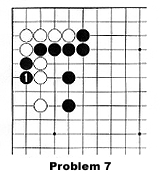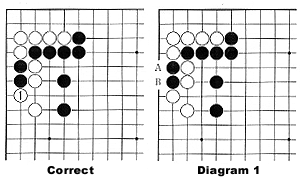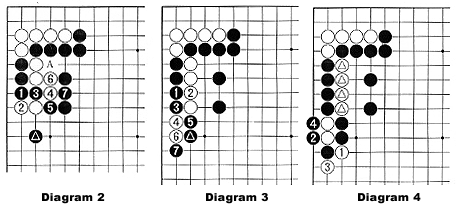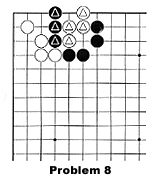Go and the Immortals
The kanji character for "sage" or "immortal" is composed of two elements which signify "mountain person." The word was applied to someone who was not only wise but ageless, someone in possession of supernatural powers and able to wander through heaven and Earth at will.In China and Japan, mountains were regarded as realms of mystery. Uncanny things happened on mountaintops, and a person who spent years among the peaks, remote from everyday concerns, was believed to acquire a type of knowledge beyond the ken of ordinary folk.
The progenitors of such awe-inspiring figures are to be found in the shamans and diviners of early China. Their activities were intimately bound up with the birth of Taoist philosophy and thus with the development of go itself.
An interesting example of the gradual growth of supernatural ideas around the go board is given by Liu Tsung-yuen, writing in 815, when he described a mountain in southern China:
"Below the shallows of the north-flowing Hsun water, and then west, is the so-called "Mountain of the Transcendents' Go Game." This mountain can be ascended from the west. There is a cavern at its top, and this cavern has screens, chambers and eaves. Under these eaves there are figures formed from flowing stone. After ascending to the topmost cavern, go out to the north and you will be looking down on a great wilderness and on flying birds--all you will discern of them is their backs. The first person to ascend here obtained a stone-and-board game on the summit, with red veins on a black surface, making eighteen pathways, suitable for go."
There are many legends about people who by chance encounter an immortal. The old Chinese story, "Ranka," which made a deep impression on the Japanese mind, tells of a certain Wang Chih, a woodcutter:
"Wang Chih was a hardy young fellow who used to venture deep into the mountains to find suitable wood for his ax. One day he went farther than usual and became lost. He wandered about for a while and eventually came upon two strange old men who were playing go, their board resting on a rock between them. Wang Chih was fascinated. He put down his ax and began to watch. One of the players gave him something like a date to chew on, so that he felt neither hunger nor thirst.
As he continued to watch he fell into a trance for what seemed like an hour or two. When he awoke, however, the two old men were no longer there. He found that his ax handle had rotted to dust and he had grown a long beard. When he got back to his native village he discovered that his family had disappeared and that no one even remembered his name."
In Japanese, the word "ranka" means "rotten ax handle," and it is often used as a poetic name for go.
In 1715, the playwright Chikamatsu made use of this legend in a scene in his play "The Battles of Coxinga." Coxinga, called Go Sankei in Chikamatsu's play, notices two old men with shaggy eyebrows and white hair absorbed in a game of go, seemingly in perfect harmony with nature. Fascinated, Go Sankei muses, "Can this be the pure world of enlightenment?" Carried away with curiosity he cries out. "Old gentlemen, I am interested to see you playing go. Is there some special pleasure to be found in this contest?"
One old man, without seeming to answer, speaks. "If it looks like a go board to you, it is a go board, and for the eye that sees go stones, they are merely go stones. But the go board is like the world. For those who see with their minds, the center of the universe is here. From the vantage point of this board, nothing will cloud our view of mountains, rivers, grasses, or trees of all China. The 90 intersections of each quarter of the board represent the 90 days of each of the four seasons. Together they come to 360. How foolish of you not to realize that we spend one day on each intersection!"
"Extraordinary!" says Go Sankei. "But why should you two oppose each other as your sole pleasure?"
"If there were not both yin and yang," the old man replies, "there would be no order in creation."
Go Sankei: "And the result of your contest?"
Old Man: "Does not the good and bad fortune of mankind depend on the chance of the moment?"
Go Sankei: "And the black and the white?"
Old Man: "The night and the day."
Go Sankei: "What are the rules?"
Old Man: "The stratagems of war."
Answer to Problem 7

 Problem 7. In this problem, set in the Jan. 30 column,
you were asked to capture the two black stones on the left. The correct answer is for White to block with 1. The black stones have no chance of surviving. White has to play on only two liberties, at A and B in Diagram 1, to completely surround and remove them from the board. When or if the white group above (which has six liberties) or the white group below (which has at least three liberties) gets into trouble, White will play on the points A and B.
Problem 7. In this problem, set in the Jan. 30 column,
you were asked to capture the two black stones on the left. The correct answer is for White to block with 1. The black stones have no chance of surviving. White has to play on only two liberties, at A and B in Diagram 1, to completely surround and remove them from the board. When or if the white group above (which has six liberties) or the white group below (which has at least three liberties) gets into trouble, White will play on the points A and B.White 1 in the correct answer is a solid move that should be played. All of White's stones are now secure. For example, suppose that in the course of a game Black plays the marked stone in Diagram 2. If White does not defend, Black can extend to 1. White blocks at 2 to prevent a linkup with the marked stone, but Black cuts through with 3 and 5. If White defends the cutting point at 6, Black ataris with 7 and he can capture four white stones with A at his leisure.
 White might defend his weakness by connecting at 2 in Diagram 3. Black would then crawl to 3. If White blocks at 4. Black cuts at 5. If White crawls to 6, Black blocks at 7, and the two white stones at 4 and 6 can't escape.
White might defend his weakness by connecting at 2 in Diagram 3. Black would then crawl to 3. If White blocks at 4. Black cuts at 5. If White crawls to 6, Black blocks at 7, and the two white stones at 4 and 6 can't escape.
If White cuts with 1 in Diagram 4, Black ataris (i.e. threatens to capture on the next move) with 2. White might also atari with 3, but Black captures two stones first with 4. All of Black's stones are secure, but the four marked white ones are essentially captured.
The variations in the diagrams above are simple examples of capturing races. that often occur in games.
 Problem 8. In this problem, the marked black and white stones are locked in a race to capture the opponent's stones. Each group has four liberties. What are Black's next two moves? The answer will appear in next week's column.
Problem 8. In this problem, the marked black and white stones are locked in a race to capture the opponent's stones. Each group has four liberties. What are Black's next two moves? The answer will appear in next week's column.
